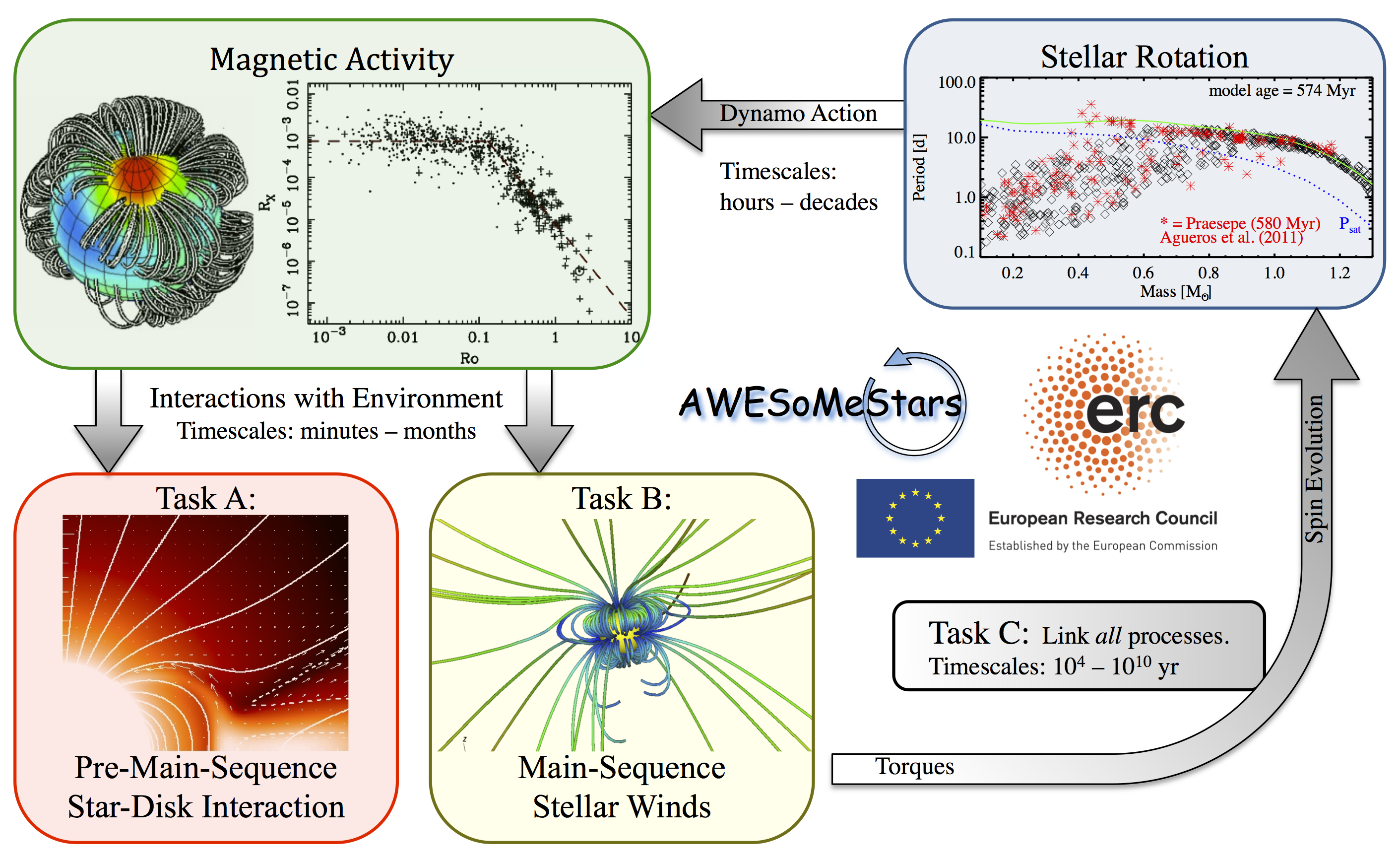The goal of the AWESoMeStars project is to develop a comprehensive and physically self-consistent picture of the evolution of stars, their rotation, magnetic activity, mass loss, and accretion. The focus is on Sun-like stars, defined here to include a mass range of ~0.1-1.3 solar masses, in the age range from protostar (~105 yr) to the age of the galaxy (~1010 yr, stopping at the subgiant phase). These stars possess convective envelopes and universally exhibit magnetic activity. They are also the most common stars in the universe, are the subject of the largest observational datasets, and are the most interesting for exoplanet discovery and habitability.
The major science objectives are:
- Discover how stars lose the vast majority of their angular momentum, which happens during the accretion phase.
- Explain the observed rotation-activity relationship and saturation in terms of the evolution of magnetic properties and coronal physics.
- Characterize coronal heating and mass loss across the full range of mass and age.
- Explain the Skumanich (1972) relationship and distributions of spin rates observed in young clusters and old field stars.
- Develop physics-based gyrochronology as a tool for using measured rotation rates to constrain stellar ages.
We are tackling these objectives using a multi-faceted approach, which combines the results from multi-dimensional MHD simulations with long-timescale rotational-evolution models. Specifically, we are developing MHD simulations of both star-disk interactions (Task A) and stellar winds (Task B), modeling stars over the full range of mass and age, and characterizing how magnetically active stars impact their environments. Simultaneously, we are developing rotational-evolution models (Task C) that include external torques derived from our simulations, computing the evolution of spin rates of entire star clusters, and comparing with a wide range of observations.
General Picture and Description of the Project Tasks

Figure 1: The AWESoMeStars project. Images: (top right)
Rotation periods vs. mass for stars in Praesepe (red stars), compared
with our cluster evolution model (black diamonds), reveal a mass- and
time-dependent, structured distribution [1]; (top left) Magnetic
field from spectropolarimetric maps of an accreting young star [2] and
X-ray/bolometric luminosity vs. Rossby no. (rot. period / convective
timescale; [3]) indicate that magnetic activity correlates with
stellar rotation rate and mass; (bottom) Magnetic field and mass
flow in the PI’s exploratory simulations of (left) star-disk
interaction simulations and (middle) simulations of stellar winds,
using the PLUTO code. These
simulations tell us how mass and angular momentum flows from stars,
which (right) changes stellar rotation rates on long timescales.
Credits: [1] Matt et al. 2015, ApJ, 799, L23; [2] Gregory et
al. 2008, MNRAS, 389, 1839; [3] Wright et al. 2011, ApJ, 743, 48.
Task A: MHD Simulations of Star-disk interactions. Use the PLUTO code to model the magnetic interactions between a forming young star and its surrounding accretion disk.
Task A1: 2D (axisymmetric) MHD simulations to study mechanisms, accretion/outflow phenomenology, and determine how torques depend on stellar and environmental conditions.
Task A2: Increase physics studied using 3D MHD simulations, and begin to couple the radiative transfer code TORUS, in collaboration with lead developer Tim Harries, to produce synthetic emission and line profiles.
Task B: MHD Simulations of Stellar winds. Use the PLUTO code to model global, magnetic stellar winds and coronae of young and main-sequence stars.
Task B1: 2D & 3D MHD simulations of stellar winds with realistic magnetic geometries, to characterize the stars’ wind environments and determine how the torque on the star depends on magnetic geometry.
Task B2: Develop MHD simulations with improved coronal heating and wind driving physics, and begin to produce synthetic emission maps and spectra (e.g., coupling simulations to CHIANTI) for stars in different regions of the rotation-activity diagram.
Task C: Model the Evolution of Rotation and Magnetic Activity. Develop spin-evolution models, using prescriptions derived from Tasks A & B, to study the long-term evolution of angular momentum, magnetic properties, mass loss, and accretion. Compare with observed distributions of rotation, outflow and accretion rates (and disk fractions), and magnetic properties of young and old clusters and field stars of unknown ages.
Task C1: Spin evolution from the youngest ages (embedded phase, ~105 yr) to the main-sequence (~100 Myr); Include effects of star-disk interaction and accretion history.
Task C2: Spin evolution up to the subgiant phase. Develop physics-based gyrochronology tools, for using measured spin rates to constrain stellar ages. Create a module to implement our models in the public stellar evolution code MESA.